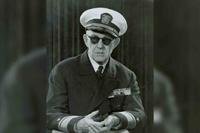August Leo Thomas was a coxswain on LCT 633 during Operation Overlord. His is a firsthand account of the landings that took place on the beaches in Normandy. Thomas displays a keen insight into the immense undertaking on which these young men of this "Greatest Generation" were embarking.
I was born May 5th, 1924, in St. Martinville, Louisiana. I was aboard the LCT 663, Flotilla 16, U.S. Navy.
I volunteered for the U.S. Navy V5 Aviation Cadet Program in November 1942 and was called in March 1943.
I washed out of the aviation program in September 1943. I went into the Navy immediately after washing out.
I was discharged from the Navy in March of 1946. I held the rank of quartermaster second class during the events discussed, and this was the highest rank I attained during my naval service.
After washing out of the Naval V-5 Aviation Cadet Program, I was sent to Quartermaster's School at Great Lakes Naval Station in Illinois. After finishing Quartermaster School, I received orders to report to LST 507.
I boarded LST 507 in Boston on March 12, 1944, and the following day was shoved off overseas. LST 507 piggybacked LCT 663 to England. We arrived in Edinburgh, Scotland, on March 29, 1944. Then we went to Plymouth, England, where the LCT 663 was launched.
I transferred to the crew of the LCT 663 at that time. We trained along the English coast from Land's End to Winter. LCT 633 was part of the ill-fated Exercise Tiger on April 28, 1944. LST 507 was sunk that night. Exercise Tiger was a D-Day rehearsal. We were to land on the beach at Slapton Sands. This never materialized; we were ordered back into port. I was a crewmember of the LCT 663 in late 1944, and we were operating out of Falmouth and Plymouth, England. June 1, 2 and 3 were anxious days filled with scuttlebutt. Landing craft were being loaded with all kinds of hardware -- trucks, tanks and munitions, etc. -- needed to fight a war.
On June 4, we received orders to get underway. We left Plymouth and went into the English Channel. We formed convoys and headed out. The weather was real bad; the seas were rough. There were many seasick soldiers aboard. There was a lot of speculation as to where we were going and when we would get there. Later, orders came to head back to port. This was a big letdown. Everyone was ready to go.
On D-Day, I was aboard the LCT 663 at 0001 hours. We were somewhere in the English Channel in convoy with other LCTs heading for France. We crossed the English Channel aboard the LCT 663. The weather was heavy, wet and windy. The channel was very rough, not ideal conditions for flat-bottomed landing craft. Many soldiers were seasick. Our IB (infantry battalion) unit, LCT 663, grouped up with Flotilla 16.
My assignment was quartermaster on duty on the conning tower. Next to the ship's skipper, I was the one charged with relaying orders from the skipper to the other members of the crew at their battle stations. We were wearing impregnated clothes over our dungarees. These clothes covered all of our bodies from the neck down. And they were hot as hell, itchy, and the odor was unbearable. Our gas masks were at hand, and we wore the standard helmets and boots.
Our initial landing was on Utah Beach shortly after H-hour. All through the night of June 5 and the early morning hours of June 6, we were underway in the English Channel. As daybreak neared, the LCT crew assumed their assigned battle stations. I don't believe anyone aboard slept this night. Our passengers were combat engineers and infantrymen. Our cargo -- the vehicles, trailers, explosives and other gear that belonged to these soldiers.
There was a lot of talk and speculation aboard. Some of the soldiers came out of the North African campaign, and one of them told us he had a feeling he would not make it this time. I often wondered about him. As daybreak approached, stillness fell, and in soft voices, you could hear different groups discussing what they thought the dawn would bring and how they would fare in all of this.
All night long, airplanes and gliders passed overhead. And all around, you could see ships of all sizes and shapes. When day broke all around us and above us, it was a sight you would have to behold to believe. A ball of flames everywhere. Fighter planes, cargo planes, gliders and bombers.
[Editor's note: The recording for this transcript was created on July 30, 1994, and is provided to Military.com by The Eisenhower Center for American Studies, University of New Orleans.]













